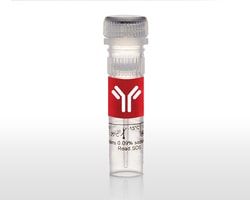beta Crystallin A3 Rabbit anti-Human, Polyclonal, Bioss
Manufacturer: Bioss
Select a Size
| Pack Size | SKU | Availability | Price |
|---|---|---|---|
| Each of 1 | 50-198-2421-Each-of-1 | In Stock | ₹ 38,381.25 |
50-198-2421 - Each of 1
In Stock
Quantity
1
Base Price: ₹ 38,381.25
GST (18%): ₹ 6,908.625
Total Price: ₹ 45,289.875
Antigen
beta Crystallin A3
Classification
Polyclonal
Conjugate
Unconjugated
Gene
CRYBA1
Gene Alias
BA3/A1; beta crystallin A3 chain transcript CN; beta crystallin A3 chain transcript LAM; beta crystallin A3 chain transcript PS; beta crystallin A3 chain transcript TC; beta-A1-crystallin; beta-A3/A1-crystallin; beta-crystallin A1; Beta-crystallin A3; Beta-crystallin A3, isoform A1, Delta4 form; Beta-crystallin A3, isoform A1, Delta7 form; Beta-crystallin A3, isoform A1, Delta8 form; Cryb; CRYB1; CRYBA1; crystallin beta A1; crystallin beta A3; crystallin beta A3/A1; crystallin, beta A1; crystallin, beta A3; CTRCT10; eye lens structural protein; truncated beta-crystallin A3
Host Species
Rabbit
Purification Method
Protein A
Regulatory Status
RUO
Gene ID (Entrez)
1411
Content And Storage
-20°C
Form
Liquid
Applications
Immunofluorescence, Immunohistochemistry (Paraffin), Western Blot
Concentration
1 μg/mL
Formulation
PBS with 1% BSA, 50% glycerol and 0.09% sodium azide; pH
Gene Accession No.
P05813
Gene Symbols
CRYBA1
Immunogen
KLH conjugated synthetic peptide derived from human beta Crystallin A3.
Quantity
100 μL
Primary or Secondary
Primary
Target Species
Human
Product Type
Antibody
Isotype
IgG
Description
- Crystallins are separated into two classes: taxon-specific, or enzyme, and ubiquitous
- The latter class constitutes the major proteins of vertebrate eye lens and maintains the transparency and refractive index of the lens
- Since lens central fiber cells lose their nuclei during development, these crystallins are made and then retained throughout life, making them extremely stable proteins
- Mammalian lens crystallins are divided into alpha, beta, and gamma families; beta and gamma crystallins are also considered as a superfamily
- Alpha and beta families are further divided into acidic and basic groups
- Seven protein regions exist in crystallins: four homologous motifs, a connecting peptide, and N- and C-terminal extensions
- Beta-crystallins, the most heterogeneous, differ by the presence of the C-terminal extension (present in the basic group, none in the acidic group)
- Beta-crystallins form aggregates of different sizes and are able to self-associate to form dimers or to form heterodimers with other beta-crystallins
- This gene, a beta acidic group member, encodes two proteins (crystallin, beta A3 and crystallin, beta A1) from a single mRNA, the latter protein is 17 aa shorter than crystallin, beta A3 and is generated by use of an alternate translation initiation site
- Deletion of exons 3 and 4 causes the autosomal dominant disease ′zonular cataract with sutural opacities′.
